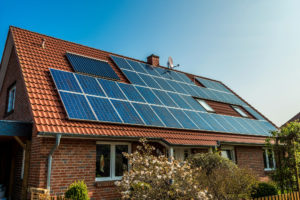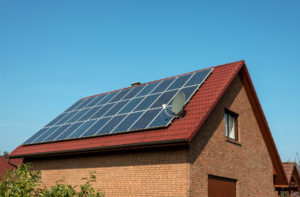As the demand for renewable energy continues to rise, solar panel systems have become a popular choice for homeowners and businesses alike. However, designing an efficient solar panel system requires careful planning and consideration. In this article, we will delve into the step-by-step process followed by solar installers to design a solar panel system that maximizes energy production, overcomes shading challenges, and ensures optimal performance.
Contents
- 1 Key Takeaways
- 2 Understanding Solar Panel Systems
- 3 Assessing Solar Potential
- 4 Determining Solar System Energy Requirements
- 5 Sizing the System
- 6 Inverter and Solar Charge Controller Selection
- 7 System Design Considerations
- 8 Monitoring and Maintenance
- 9 Case Study: Designing a Customized Solar Panel System for Maximum Efficiency
- 10 Expert Insights From Our Solar Panel Installers About Designing a Solar Panel System
- 11 Experience Solar Excellence with Us!
- 12 Conclusion
Key Takeaways
- Solar installers follow a step-by-step process to design solar panel systems, considering solar potential, energy requirements, system sizing, inverter and charge controller selection, system design considerations, and monitoring and maintenance.
- Assessing solar potential involves analyzing sunlight availability, shading challenges, and optimizing panel placement.
- Determining energy requirements ensures the system meets current and future energy demands while sizing the system involves calculating the appropriate number of panels based on energy requirements and available sunlight. Inverter and charge controller selection are crucial for efficient energy conversion, and system design considerations focus on addressing shading and ensuring electrical safety and compliance. Monitoring and maintenance help optimize system performance and longevity.
Understanding Solar Panel Systems
A solar panel system, also known as a photovoltaic (PV) system, consists of several key components. The primary component is the solar panel itself, which converts sunlight into electricity. Solar panels are typically made of photovoltaic cells that harness the energy from sunlight and generate a direct current (DC) output. These panels are designed to be weather-resistant and durable to withstand various environmental conditions.
In addition to solar panels, an essential component of a solar panel system is the inverter. The inverter plays a crucial role in converting the DC electricity generated by the solar panels into alternating current (AC) electricity, which is suitable for powering appliances and electrical systems in homes and businesses. By transforming the DC energy into AC energy, the inverter enables the utilization of solar power within the existing electrical infrastructure.
Another critical component is the charge controller. While it may not be necessary for all solar panel systems, the charge controller is especially relevant for off-grid or hybrid systems with battery storage. The charge controller regulates the flow of electricity from the solar panels to the battery bank, ensuring efficient charging and preventing overcharging or deep discharge. This helps to extend the lifespan of the batteries and maximize their performance.
Assessing Solar Potential
Before designing a solar panel system, solar installers must thoroughly assess the solar potential of the installation site. This involves conducting a comprehensive solar site analysis to determine the amount of sunlight available throughout the day and the year. Solar installers can identify potential obstacles affecting system performance by evaluating factors such as shading from nearby objects or structures and make necessary adjustments during the design phase.
The solar site analysis involves careful consideration of various elements. The orientation and tilt angle of the solar panels are critical factors in optimizing energy production. Solar panels are typically installed facing south to maximize exposure to the sun throughout the day. However, in cases where south-facing installation is not feasible, adjustments can be made to capture the available sunlight efficiently.
Furthermore, the impact of shading on the solar panel system cannot be overlooked. Shading from trees, buildings, or other structures can significantly reduce energy production and compromise system performance. Solar installers employ shading analysis tools and techniques to overcome shading challenges, such as using shade analysis software or physically assessing shading patterns at different times of the day and year. By identifying potential shading issues in advance, installers can design the system to minimize shading and maximize solar energy capture.

Determining Solar System Energy Requirements
Accurately determining the energy requirements of the property or system owner is a crucial step in designing a solar panel system. This involves analyzing historical energy consumption patterns and considering future energy needs to ensure the system effectively meets the property’s power demands.
Solar installers gather data on the property’s energy consumption from previous utility bills or monitoring systems. This data helps understand the property’s energy usage patterns, including peak demand periods and fluctuations throughout the year. By studying this information, solar installers can identify the average daily energy consumption and the highest energy demand periods.
In addition to historical data, solar installers consider the future energy needs of the property. This involves discussing the property owner’s plans for expansion, any anticipated changes in energy consumption due to lifestyle or business growth, and the potential addition of energy-intensive appliances or equipment. By factoring in these considerations, solar installers can design a solar panel system that meets the current energy requirements and accommodates future growth.
Sizing the System
Solar installers carefully determine the appropriate size of the system to optimize energy production and ensure the solar panel system meets the property’s energy needs. This involves considering various factors, including energy requirements, available sunlight, and the solar panels’ characteristics.
The first step in sizing the system is calculating the property’s average daily energy consumption. Solar installers use historical energy consumption data and discussions with the property owner to establish an accurate baseline for energy requirements. This information serves as the foundation for determining the system’s capacity.
Next, solar installers consider the available sunlight at the installation site. Factors such as the solar panels’ location, orientation, and tilt angle play a crucial role in determining the system’s energy production potential. Solar installers can estimate the amount of energy the solar panel system can generate by analyzing solar irradiance data specific to the region and accounting for any shading issues identified during the solar site analysis.
Lastly, solar panel characteristics such as efficiency and wattage are considered. Higher-efficiency panels can generate more electricity from the same amount of sunlight, making them a preferred choice for maximizing energy production. Solar installers also consider the panels’ nominal voltage and current ratings to ensure compatibility with the chosen inverter and charge controller.
By carefully assessing these factors and performing detailed calculations, solar installers can determine the optimal number of solar panels required for the system. This includes considering the configuration of the solar panel array, whether it is a series or parallel configuration, to achieve the desired voltage and current levels.

Inverter and Solar Charge Controller Selection
Selecting the appropriate inverter and charge controller is critical to the overall performance and efficiency of the solar panel system. The inverter is responsible for converting the DC electricity generated by the solar panels into AC electricity that can be used to power appliances and electrical systems.
Solar installers consider several factors when selecting the inverter. The first consideration is the system’s size and capacity. Inverters are available in different sizes, and it is essential to choose an inverter that can handle the maximum power output of the solar panel system. Additionally, the inverter’s efficiency is an important consideration. Higher-efficiency inverters can maximize the conversion of DC to AC electricity, minimizing energy losses.
Furthermore, solar installers evaluate the inverter’s compatibility with the solar panels and system configuration. Different inverters have different voltage and current input requirements, and they must match the specifications of the solar panel array. Solar installers also consider whether to use a string inverter or micro-inverters. String inverters are typically used for systems with multiple solar panels connected in series. At the same time, micro-inverters are installed on each solar panel individually, allowing for independent operation and increased system performance.
In systems with battery storage, selecting an appropriate charge controller is crucial. Charge controllers regulate the flow of electricity between the solar panels and the battery bank, ensuring efficient charging and preventing overcharging or deep discharge. Solar installers consider factors such as the nominal voltage and current ratings of the solar panels and batteries and the charge controller’s capacity and features, such as maximum power point tracking (MPPT) capability.

System Design Considerations
Solar installers consider various factors to optimize system performance, reliability, and safety when designing a solar panel system. These considerations include:
Shading
Shading can have a significant impact on the performance of a solar panel system. Solar installers carefully evaluate the installation site and assess potential shading issues. They consider the shading patterns throughout the day and year to determine the best placement of solar panels and minimize the effects of shading. This may involve adjusting the tilt angle, choosing alternative mounting locations, or using shading mitigation techniques such as trimming nearby trees or installing shade awnings. By addressing shading concerns during the design phase, solar installers can ensure that the solar panel system operates at its maximum potential.
Mounting Options
Solar installers consider the available mounting options for the solar panel system. The two most common mounting methods are roof-mounted and ground-mounted systems. Roof-mounted systems are popular for residential installations, as they utilize existing roof space to maximize energy production. Ground-mounted systems, on the other hand, offer flexibility in terms of panel orientation and tilt angle, making them suitable for larger installations or sites with suboptimal roof conditions. The choice of mounting option depends on factors such as available space, site characteristics, and the property owner’s preferences.
Electrical Safety and Compliance
Solar installers prioritize electrical safety and compliance with local regulations when designing a solar panel system. They ensure that the system adheres to the required electrical codes and standards to minimize the risk of electrical hazards. This includes proper grounding, adequate circuit protection, and appropriate wiring and conduit materials. By following best practices for electrical safety and compliance, solar installers ensure the system is safe, reliable, and compliant with all applicable regulations.
Monitoring and Maintenance
Once the solar panel system is installed, regular monitoring and maintenance are essential to optimize performance and ensure longevity. Solar installers recommend implementing a monitoring system that tracks energy production, system performance, and any potential issues. This allows property owners to identify and address any inefficiencies or malfunctions promptly. Regular maintenance practices, such as cleaning the solar panels to remove dirt and debris, inspecting electrical connections for any signs of wear or damage, and checking the performance of the inverter and charge controller, help maintain the system’s optimal operation. Solar installers may also offer periodic maintenance services to ensure the system continues to generate maximum energy output.
Case Study: Designing a Customized Solar Panel System for Maximum Efficiency
Background
At Solar Panels Network USA, we were contacted by a commercial property owner who wanted to install a solar panel system to reduce their energy costs and environmental footprint. The property had a large, flat roof with some shading from nearby buildings, making it an ideal candidate for a customized solar solution.
Project Overview
The project involved designing a solar panel system tailored to the specific needs and conditions of the property. Key considerations included assessing the solar potential, determining energy requirements, sizing the system, and selecting the appropriate components to ensure optimal performance.
Implementation
Solar Potential Assessment: We conducted a comprehensive solar site analysis to determine the sunlight availability throughout the year. Using shading analysis tools, we identified potential obstacles and optimized the panel placement to minimize shading and maximize sunlight exposure.
Energy Requirements Evaluation: We analyzed the property’s historical energy consumption and discussed future energy needs with the owner. This helped us accurately determine the system’s capacity, ensuring it could meet current and anticipated energy demands.
System Sizing and Design: Based on the solar potential and energy requirements, we calculated the optimal number of solar panels needed. We selected high-efficiency monocrystalline panels to maximize energy production. The system design included a mix of roof-mounted and ground-mounted panels to fully utilize the available space.
Component Selection: We chose a string inverter for its cost-effectiveness and compatibility with the system size. Additionally, we incorporated a charge controller to regulate the flow of electricity and prevent overcharging the battery bank, ensuring efficient energy storage and use.
Cost Considerations: We provided a detailed quote outlining the costs of components, installation, permits, and electrical work. The quote included a cost-benefit analysis, showing the potential energy savings and return on investment over the system’s lifespan.
Professional Installation: Our experienced technicians handled the installation, ensuring the panels were securely mounted and all components were integrated seamlessly. The installation process adhered to all safety and electrical standards.
System Optimization and Testing: After installation, we conducted thorough testing to ensure the system was functioning optimally. We verified the performance of the panels, inverter, and charge controller, making necessary adjustments to maximize energy production.
Results
The customized solar panel system provided the following benefits:
- Maximized Energy Production: The optimized design and high-efficiency panels significantly increased energy output, meeting the property’s energy needs.
- Improved Efficiency: The selected components ensured efficient energy conversion and storage, reducing energy losses and enhancing system performance.
- Cost Savings: The property owner experienced substantial savings on energy bills, with a projected payback period of 6-8 years.
- Environmental Impact: The solar panel system significantly reduced the property’s carbon footprint, contributing to sustainability goals.
Summary
This case study highlights the importance of a comprehensive and customized approach to designing solar panel systems. By assessing solar potential, accurately determining energy requirements, carefully sizing the system, and selecting high-quality components, Solar Panels Network USA delivered a solution that maximized energy production and efficiency. This project exemplifies our commitment to providing tailored solar solutions that meet the unique needs of our clients, ensuring long-term benefits and sustainability.
Expert Insights From Our Solar Panel Installers About Designing a Solar Panel System
Designing a solar panel system requires a detailed assessment of the installation site and energy needs. We evaluate sunlight availability, potential shading, and roof space to create a customized design that maximizes energy production.
Senior Solar Installer
The choice of inverter and charge controller is crucial for an efficient solar panel system. By selecting high-quality components that match the system’s specifications, we ensure optimal energy conversion and storage.
Lead Solar Technician
Regular monitoring and maintenance are essential for maintaining system performance. Implementing advanced monitoring systems helps us detect issues early and ensure the solar panels operate at peak efficiency.
Solar System Specialist
Experience Solar Excellence with Us!
Trust in Solar Panels Network USA, where our seasoned experts deliver top-quality solar solutions for homes and businesses nationwide. With a legacy of countless successful installations and a commitment to sustainable energy, we’re your reliable partner in the solar journey. Ready for a brighter, eco-friendly future? Call us now at (855) 427-0058 and harness the power of the sun!
Conclusion
Designing a solar panel system requires a comprehensive approach considering various factors to maximize energy production and overcome potential challenges. By understanding the components of a solar panel system, assessing the solar potential of the installation site, determining energy requirements accurately, sizing the system appropriately, selecting the right inverter and charge controller, considering system design considerations, and implementing effective monitoring and maintenance practices, solar installers can design solar panel systems that deliver efficient, reliable, and sustainable solar energy.
About the Author
Solar Panels Network USA stands at the forefront of solar energy solutions, driven by a team of seasoned solar engineers and energy consultants. With over decades of experience in delivering high-quality solar installations and maintenance, we are committed to promoting sustainable energy through customer-centric, tailored solutions. Our articles reflect this commitment, crafted collaboratively by experts to provide accurate, up-to-date insights into solar technology, ensuring our readers are well-informed and empowered in their solar energy decisions.

